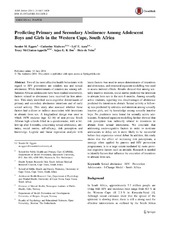| dc.contributor.author | Eggers, Sander M. | |
| dc.contributor.author | Mathews, Catherine | |
| dc.contributor.author | Aarø, Leif Edvard | |
| dc.contributor.author | McClinton-Appollis, Tracy | |
| dc.contributor.author | Bos, Arjan E.R. | |
| dc.contributor.author | de Vries, Hein | |
| dc.date.accessioned | 2017-08-16T09:22:20Z | |
| dc.date.available | 2017-08-16T09:22:20Z | |
| dc.date.issued | 2017-05 | |
| dc.Published | Eggers SM, Mathews C, Aarø LE, McClinton-Appollis, Bos AE, de Vries H. Predicting Primary and Secondary Abstinence Among Adolescent Boys and Girls in the Western Cape, South Africa. Aids and Behavior. 2017;21(5):1417-1428 | eng |
| dc.identifier.issn | 1573-3254 | |
| dc.identifier.issn | 1090-7165 | |
| dc.identifier.uri | https://hdl.handle.net/1956/16301 | |
| dc.description.abstract | Two of the most effective health behaviours with regard to HIV prevention are condom use and sexual abstinence. While determinants of condom use among sub-Saharan African adolescents have been studied extensively, factors related to abstinence have received far less attention. This study identified socio-cognitive determinants of primary and secondary abstinence intentions and of early sexual activity. This study also assessed whether these factors had a direct or indirect association with intentions to abstain from sex. A longitudinal design was used in which 1670 students (age 12-16) of non-private South African high schools filled in a questionnaire, with a follow-up after 6 months, concerning sexual abstinence, attitudes, social norms, self-efficacy, risk perception and knowledge. Logistic and linear regression analysis with latent factors was used to assess determinants of intentions and abstinence, and structural equation modelling was used to assess indirect effects. Results showed that among sexually inactive students, social norms predicted the intention to abstain from sex in the next 6 months. Among sexually active students, reporting less disadvantages of abstinence predicted the intention to abstain. Sexual activity at follow-up was predicted by attitudes and intention among sexually inactive girls, and by knowledge among sexually inactive boys. No predictors were found for sexually active adolescents. Structural equation modelling further showed that risk perception was indirectly related to intentions to abstain from sexual intercourse. We conclude that addressing socio-cognitive factors in order to motivate adolescents to delay sex is more likely to be successful before they experience sexual debut. In addition, this study shows that the effect of increasing risk perceptions, a strategy often applied by parents and HIV prevention programmes, is to a large extent mediated by more proximal cognitive factors such as attitude. Research is needed to identify factors that influence the execution of intentions to abstain from sex. | en_US |
| dc.language.iso | eng | eng |
| dc.publisher | Springer | eng |
| dc.relation.uri | https://link.springer.com/content/pdf/10.1007%2Fs10461-016-1438-2.pdf | |
| dc.rights | Attribution CC BY | eng |
| dc.rights.uri | http://creativecommons.org/licenses/by/4.0 | eng |
| dc.subject | Sexual abstinence | eng |
| dc.subject | HIV | eng |
| dc.subject | Prevention | eng |
| dc.subject | Adolescents | eng |
| dc.subject | I-Change Model | eng |
| dc.subject | South Africa | eng |
| dc.title | Predicting Primary and Secondary Abstinence Among Adolescent Boys and Girls in the Western Cape, South Africa | eng |
| dc.type | Peer reviewed | |
| dc.type | Journal article | |
| dc.date.updated | 2017-06-21T11:00:46Z | |
| dc.description.version | publishedVersion | |
| dc.rights.holder | Copyright 2016 The Author(s) | eng |
| dc.identifier.doi | https://doi.org/10.1007/s10461-016-1438-2 | |
| dc.identifier.cristin | 1477910 | |
| dc.source.journal | Aids and Behavior | |

